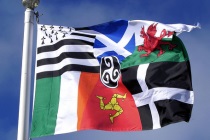Fairy Pools community land acquisition on Skye and need for long term tourism strategy
On the Isle of Skye (Scottish Gaelic: An t-Eilean Sgitheanach), the belief in the existence of fairies, or “the little people,” goes back to prehistoric times. Something that they share with some other Celtic peoples. A number of places on Skye are associated with this local legend. Locations like naturally occurring pools typically under waterfalls are seen as a favoured site for the little people to gather. The mystery of such places can be enhanced by magnificent rock formations, swirling streams, little waterfalls and pools that can sometimes be coloured by minerals and tinged with blue-green algae that can give them a mystical quality.
One such place on Skye are the waterfalls that feed what are known as the Fairy Pools. They are on the Allt Coir' a' Mhadaidh river as it cascades down from the Cuillin Hills, through Glen Brittle (Gleann Breadail). The word glen is of Gaelic origin describing a valley (gleann in Irish and Scottish Gaelic and glion in Manx). As can often be the case in this part of Scotland and the Isle of Man, there can be a fusion in place names between Gaelic and Norse and so the name Gleann Bredail is probably derived from old Norse Bred Dal ("broad valley") and the Gaelic glean ("valley"). The Fairy Pools are very popular places to visit for walkers and those who brave the cold waters to swim in the Pools.
Their popularity, however, is in danger of taking away some of the magic from the Fairy Pools. Local residents and visitors alike have voiced concerns about the lack of infrastructure to cope with the numbers visiting the site. Now local people have been able to buy land near Fairy Pools to try and help deal with the problem. Minginish Community Hall Association (MCHA) is the first to make use of a scheme which allows publicly-owned forestry assets to be transferred for the benefit of local communities. The scheme is run by Forest Enterprise Scotland (FES). MCHA have bought 12.3 hectares of land at a discount on the market value. Their aim is not to prevent people from visiting, but to ease the pressure on locals and visitors alike.
At the present time access is restricted by a single-track road and a 35-space car park. MCHA plan to make space for 137 cars and about 20 mini-buses and camper vans with the aim of reducing congestion. The issue also applies to other areas of Skye, which is becoming increasingly popular with tourists. The local economy and businesses benefit from tourism but many have pointed out that there needs to be a balance so that people are able to enjoy Skye without them putting additional pressures on the landscape and services. At the same time people don't want to turn Skye into a kind of Disneyland which would ruin the island's culture and heritage. There are now increasing calls for an overall tourism strategy that looks 10, 20 or 30 years ahead to achieve this aim of creating a balance of protecting the environment, culture and heritage, while at the same time welcoming visitors.






